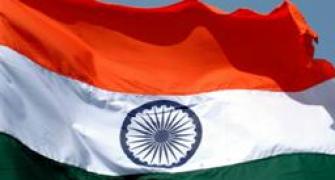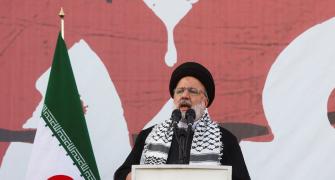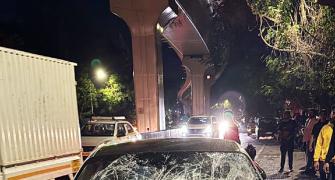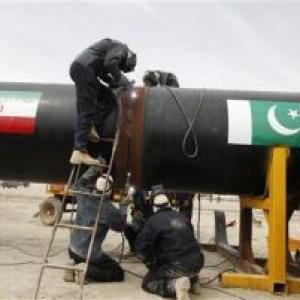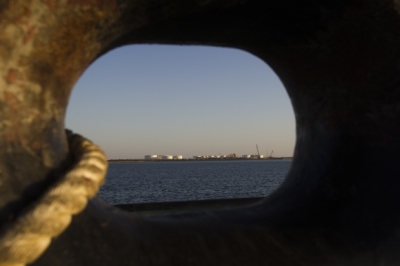 Developing the Chabahar port in Iran addresses India’s geopolitical as well as economic challenges, says Jyoti Malhotra
Developing the Chabahar port in Iran addresses India’s geopolitical as well as economic challenges, says Jyoti Malhotra
Last month, the Indian leadership woke from its ten-year slumber, dusted the files, smothered a yawn at the Cabinet meeting and finally sanctioned $100 million to be spent on the upgradation of the Chabahar port in Iran. In 2003, the project had been discussed when then president of Iran, Mohammad Khatami, had come calling to explore options on securing the region post the terrorist events of September 11, 2001.
Now, as the United States prepares to withdraw from Afghanistan next year, Chabahar has become a key piece in a chess match in which nations play shadowy games for mercenary self-interest as well as the selective consolidation of the other’s sphere of influence.
Chabahar was a fishing port even in 1613, when the British and the Portuguese jockeyed here for maritime superiority, keenly aware that its location just off the Persian Gulf -- and the Straits of Hormuz -- was a significant asset. (As much as 17 per cent of the world’s oil passes through the Straits, which if Iran ever shuts down, as it sometimes threatens to, would raise the price of oil by 50 per cent.)
To properly understand the geostrategic location of Chabahar, note that only 74 km and further up the Makran coast is Gwadar, a second port in Pakistan that has been jointly developed by the Port of Singapore Authority and the China Harbour Engineering Co Ltd since 2007.
Singapore pulled out in 2012, having spent some $50 million, citing the Pakistan government’s inability to abide by the contract (Pakistan, in its defence, cited a Supreme Court order which prohibited them from transferring land to a foreign company). The Chinese, always the majority partner, have spent $198 million out of $248 million so far.
With Singapore exiting from Gwadar, it seemed that the penny finally dropped in South Block. The Chinese were no longer coming, that war cry was good for black-and-white movies; they were already here, right in your neighbourhood, right under your nose. In any case, there are no rewards for sustained navel-gazing in the brutal world of realpolitik. If India was going to be so self-absorbed in its politics that it had no time to ponder over China’s expanded outreach in South Asia, then that would be India’s problem.
When the penny dropped and Rip Van Winkle awoke, it seemed that in the decade since Khatami had come to Delhi to discuss his philosophy of civilisations, the Chinese had cast a tantalising net of economic linkages across the length and breadth of South Asia.
The basic unit of temptation was the loan-at-very-low-interest, almost too good to be true. The Chinese were becoming the self-appointed bankers of South Asia, quietly creeping up with the mission of becoming the go-to people, thereby enhancing the dependencies of nations. The promise of transforming these poor countries through cheap money was the new opium of their masses.
Everywhere you looked, the Chinese seemed to show up. In Sri Lanka, they were building roads and football stadiums; in Bangladesh, they were offering to revamp and redevelop the Chittagong port; in Hindu-majority Nepal, they were flooding the market with cheap goods; in Afghanistan, they were buying up cooper and gold mines and scouting for oil reserves. In Pakistan, meanwhile, they were consolidating their “all-weather friendship” with the building of a second port, at Gwadar, that would allow them to keep an eye on America’s heavy deployment of frigates and an aircraft carrier as well as on the to-ing and fro-ing of oil tanks through the Straits of Hormuz.
It was enough to passionately start believing in the “string of pearls” theory, a throwaway remark coined by a bored American researcher but which has since become part of international jargon, a reference to the Chinese network of influence that Beijing has cast around India’s neck. Gwadar was only the latest pearl that had been added by the master-stringer at Zhongnanhai in Beijing.
The Chabahar file was finally retrieved from the inbox. Developing that port addressed two geopolitical challenges at the same time, that of dealing with China as well as Pakistan. Developing Chabahar would not only provide an alternative to China’s expanding influence across South and Central Asia -- of which Gwadar in Pakistan and the Aynak copper mines were only two manifestations -- it also circumvented Pakistan’s determined attempts at being the only route into and out of Afghanistan and Central Asia.
In addition, you could make the case for connecting Chabahar with the North-South Corridor Initiative, wherein Indian goods would sail to the Iranian port, then travel by rail to Mashhad on the northern border and onwards into Azerbaijan and southern Russia, dock at Astrakhan and then travel up the Volga river into the heartland of Russia.
<P align="center">
<B>* * * * *</B>
</P>
In a country with ideas and an accompanying vision, Chabahar could well become the lynchpin of its Afghanistan and Central Asian strategy. In fact, Delhi saw, Teheran had already spent about $340 million in the development of Chabahar.
Once again, economics would be employed in the service of politics, offering India the chance to return to a region it had been kept out of for at least 20 years, since the death of its old friend and former Afghan president Mohammad Najibullah in 1996. Najib had been hanged from a lamp-post by the invading Taliban, an army of religious students trained to fight the ‘infidel’ by the Pakistan army, and had the covert support of the Benazir Bhutto government in Islamabad.
He had been an Ahmadzai Pashtun, the one-time head of the Afghan intelligence during the pro-Soviet regime of Babrak Karmal as well as a very good friend of India -- and therefore, an enemy of the Pakistanis next door. When the Taliban hordes came in 1996, they pulled Najibullah out of the United Nations compound to which he had moved after his own presidential palace became too insecure and proceeded to summarily execute him.
With the Taliban in power in Kabul, recognised only by three countries in the world -- Pakistan, the UAE and Saudi Arabia -- India had been well and truly excommunicated.
With the fall of the Taliban in 2001, India moved quickly with the promise of economic aid to rebuild Afghanistan, using a few hundred Small Development Projects (totalling $100 million) to build local roads, digging wells, the compound walls of schools and sometimes, even schools. On the other side of the spectrum were the more visible initiatives, such as building power transmission lines from Kabul to the northern border of Afghanistan with Uzbekistan, check dams in the Hazara region, the parliament building in Kabul and thousands of scholarships to Afghan students, diplomats, officials, etc, to come to India. At last count, India’s economic aid to Afghanistan had totalled $2 billion.
The peace and brotherhood was all very well, only there were no straightforward options for India to undertake the ambitious economic transformation of Afghanistan. Pakistan lay in the way and it had decided that Indian goods and machinery would simply not be allowed to cross its territory en route to Afghanistan.
In the early years, Indian Airlines planes would carry heavy machinery as cargo, but air freight could never be a long-term solution. Meanwhile, Pakistan was pressed by its long-term ally, the US, to open up the Durand Line and allow Afghan-Pakistan trade; as a gesture to their fellow Muslims, the Pakistanis allowed, as part of the Afghan-Pakistan trade and transit agreement, Afghan trucks to come all the way up to the India-Pakistan border at Wagah and unload their haul of super-sweet melons and pomegranates and apples and dry fruit. The catch was that the Afghan trucks had to go back empty. Indian goods would not be allowed to be packed into those Afghan trucks.
The Pakistanis knew they had the Afghans as well as the Indians by the jugular. Both policies were still made and implemented at the army headquarters in Rawalpindi, the only difference being that the army had slowly come on board the former ruling Pakistan People’s Party’s determination to open up trade with India.
On Afghanistan, though, no quarter was given to the political class and none was asked. The Pakistan army refused to countenance the possibility of another country -- India -- displacing itself in Afghanistan’s hearts and minds and would do everything in its ability to retain its “strategic depth” inside Afghanistan, even if it had to be done by force.
The Pakistan army’s antagonism was so deep-seated, it was willing to sacrifice the benefits of economic ties for its old friends, the Afghans, at the altar of its intense dislike for India. Unfortunately, it would soon find out that the sweet taste of revenge can also, sometimes, become sour.
Enter Chabahar. The Iranian port had been used once in 2011 to send tonnes of wheat biscuits to Afghanistan. Interestingly, the Pakistanis had allowed the use of Karachi port a couple of times for the docking and unloading and onward journey of Indian wheat meant for Afghanistan, under UN auspices. India had to find a way to maintain the lines of economic assistance on a more permanent basis. Chabahar increasingly looked like the perfect alternative, notwithstanding the fact that it was a more expensive route and that in early 2012 the Americans decided to impose economic sanctions against Iran.
Considering that Iran was the second-largest supplier of crude, India was deeply upset at the imposition of sanctions. There seemed no way out, though, since the Americans had slowly become a key ally in the pursuit of domestic and foreign policy goals. It pushed for exemption from the sanctions process and was granted it.
Now India argued that the sale of food commodities and medicines, exempt from sanctions, had to be complemented with the development of port infrastructure. Yes, that was done too.
The wheel was turning a full circle. As it planned its withdrawal from Afghanistan, the Americans quietly allowed the Afghans to import oil through Iran and opened up secret talks on a post-2014 scenario. Teheran was seemingly no longer the Great Satan it once was.
India’s friendship with Iran, especially its centre-staging of Chabahar, had helped Iran restore some of the strategic influence it once enjoyed in west and central Asia. Even the Americans had begun to recognise that.
Image: A general view of an oil dock is seen from a ship at the port of Kalantari in the city of Chabahar | Photograph: Raheb Homavandi/Reuters



